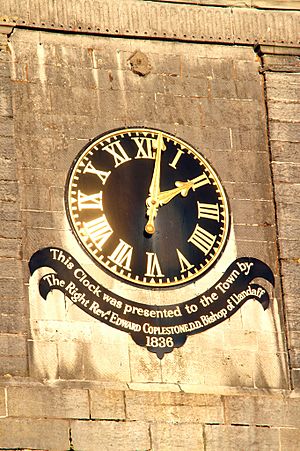Cowbridge Town Hall facts for kids
Quick facts for kids Cowbridge Town Hall |
|
|---|---|
| Native name Neuadd y Dref Y Bont-faen | |

Cowbridge Town Hall
|
|
| Location | Cowbridge |
| Built | 1806 |
|
Listed Building – Grade II*
|
|
| Designated | 5 December 1963 |
| Reference no. | 13200 |
| Lua error in Module:Location_map at line 420: attempt to index field 'wikibase' (a nil value). | |
Cowbridge Town Hall (which is Neuadd y Dref Y Bont-faen in Welsh) is an important building in the High Street of Cowbridge, South Wales. It's where the Cowbridge with Llanblethian Town Council meets to make decisions for the town.
The building also has offices for the town clerk and special committee rooms. A cool part of the Town Hall is the Cowbridge Museum, which you can visit! This historic building is so special that it's a Grade II* listed building, meaning it's protected.
Contents
The Story of Cowbridge Town Hall
The Town Hall was built to replace an older building called a guildhall. That old guildhall was in the middle of the High Street. It was used for town meetings and important legal gatherings.
However, the old guildhall made it hard for traffic to move. So, town leaders decided to find a new place. They chose a building from 1806 that used to be a prison. This prison was called a "House of Correction."
From Prison to Town Hall
The prison became empty when all the correctional activities moved to Swansea. In 1823, plans of the old prison showed it had two floors. It also had walls from the prisoners' exercise yards. These walls were used to create more rooms for the new Town Hall.
In 1824, a Reverend named John Montgomery Traherne paid for the plans. He also paid for the estimated costs to build the new Town Hall. Later, in 1829 and 1830, the town thanked Isaiah Verity. He offered the land for the Town Hall.
Verity was given the "freedom of the borough" for his help. This was a special honor. The building officially became the Town Hall in 1830.
Changes and Features
The Town Hall was made bigger in 1895. Inside, it had two main committee rooms. There was also a special room for the mayor. If you look closely in the mayor's room, you can still see parts of an old well. These wells were in the exercise yards for the prisoners.
The front of the building has a balanced design with five sections. The middle section has a doorway with a pointed roof. It also has a small round window above it. The building has a two-part clock tower on the roof. This tower has a small dome called a cupola.
The clock in the tower was a gift from Edward Copleston. He was the Bishop of Llandaff. In 1921, a war memorial was placed in front of the Town Hall. It remembers local people who died in the First World War. The building was also updated in 1974.
The Cowbridge Museum
The Cowbridge Museum opened in the 1980s. It uses six of the old prison cells. These cells now hold and display the museum's collection. It's a unique way to see history!


